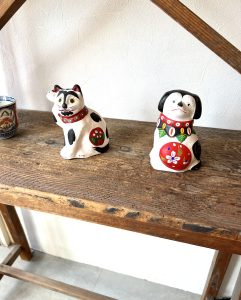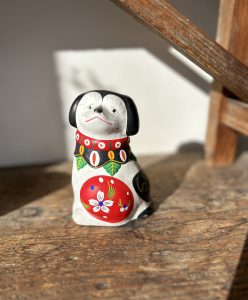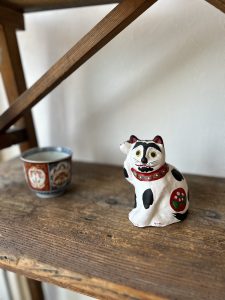動物の人形に癒されます(愛知県名古屋市千種区姫池通 骨董買取 古美術風光舎)
2024.02.08
皆さまこんにちは。スタッフHでございます。
今日は過ごしやすい良い天気かと思いきや、通勤途中でかなりの突風にあおられ、思わずマフラーで顔を覆ってしまいました。今年は暖冬と言われておりますが油断大敵ですね。
この寒空の下でも、犬のお散歩をされている方をよくみかけます。種類にもよるのかもしれませんが、犬は本来「探求したい」という欲求をもっていて、散歩はこの欲求を満たすためにも必要なのだとか。私は今はペットを飼っていないので、お散歩している可愛い犬を見ると欲しくなってしまいますが、責任の重さにいつも後退りしてしまいます。
さて、私のペットではないのですが、いつもなんとも言えない表情で癒してくれる可愛い猫と犬の人形が店内にございます。どちらも雰囲気が似ていますが、持ってみると重さが違い、作られている地域も違うようです。

犬の人形は岩手県花巻市の花巻土人形で、宮城県仙台市の堤人形、山形県米沢市の相良(さがら)人形と並び「東北三大土人形」として知られています。花巻土人形は江戸時代中期頃、京都の伏見人形の型をもとに仙台の堤人形の影響を受け作り始めたとされています。赤、青、緑といった鮮やかな色調や梅、桜、牡丹などの花をあしらったデザインが特徴です。雛人形、恵比須、大黒天などの縁起物から動物や干支など様々なモチーフがあります。一度は製作が途絶えましたが、地元の郷土玩具を制作していた平賀工芸社や花巻市により再興されたとのこと。
色彩の中でも赤が目立つデザインが多く、これは赤が病魔を祓う色とされ、子供に疫病がとりつかないようにとの願いが込められています。また犬のモチーフは安産や健康を祈願する縁起物とされ、子供の健やかな成長を願って作れた人形なのでしょう。それにしてもこの垂れた目と少しへの字に曲がった口の愛らしさ。こんな表情で見上げられたらなんでも言うことを聞いてしまいそうです。

花巻人形は素焼きの人形に彩色を施しており、少し重みがありますが、招き猫の人形は大変軽いです。
こちらは岩手県遠野に工房がある孝洞(佐々木和孝)さんの附馬牛人形(つきもうしにんぎょう)です。原料の和紙と土を練り合わせ型取りし、自然乾燥させたものです。焼いていないため軽く、とてもしっかりしています。
江戸末期から明治初めまで遠野市の小笠原家で親子二代が作っただけの附馬牛人形でしたが、佐々木和孝さんが120年ぶりに復元され、今は奥様が制作されているそうです。作風は伏見人形、堤人形、花巻人形の流れをくんでいると言われています。

こちらの招き猫も表情がユニークです。口の下に黒く塗られているのは何だろうを思って調べますと、土人形には竈猫(かまどねこ)というモチーフがあったそうです。「結構毛だらけ猫灰だらけ」という言葉がありますが、昔は冬に猫が灰らけになるのは普通の光景だったようで、寒がりの猫が人間が火の始末をして寝た後に竈の中に潜り込んでいたとか。こうして灰だらけになった猫を「竈猫」と呼んだようです。確かに郷土人形を見ると口の周りが真っ黒な猫を見かけます。灰だらけの猫をそのまま人形にするなんて大らかで、のどかなお話でしょう。
それにしましても一度は途絶えた技術を復活させ、後世に伝えてくださる方々の努力には頭が下がります。
それでは、また次の機会に。
Hello everyone. This is Staff H.
I thought today’s weather would be pleasant and comfortable, but on my way to work, I was hit by a gust of wind that made me cover my face with my scarf. It is said to be a mild winter this year, but you can never be too careful.
Even in this cold weather, I often see people walking their dogs. It may depend on the breed of dog, but I hear that dogs have a natural desire to “explore” and that walking is necessary to satisfy this desire. I don’t have a pet at the moment, so when I see a cute dog being walked, I want one, but I always fall back on the weight of responsibility.
Now, although they are not my pets, there are cute cat and dog dolls in the store that always soothe me with their indescribable expressions. Both dolls have a similar atmosphere, but when you hold them, you can see that they weigh differently and are made in different regions.
The dog doll is a Hanamaki clay doll from Hanamaki City, Iwate Prefecture, and is known as one of the “three major clay dolls in Tohoku” along with the Tsutsumi doll from Sendai City, Miyagi Prefecture, and the Sagara doll from Yonezawa City, Yamagata Prefecture. Hanamaki clay dolls were first made around the middle of the Edo period (1603-1867), based on the Fushimi doll pattern from Kyoto and influenced by Tsutsumi dolls from Sendai. They are characterized by bright colors such as red, blue, and green, and designs decorated with flowers such as plum blossoms, cherry blossoms, and peonies. Various motifs are available, from lucky charms such as Hina dolls, Ebisu, and Daikokuten to animals and the Chinese zodiac. The production of these toys once ceased, but was revived by Hiraga Kogeisha, a local toy manufacturer, and Hanamaki City.
The red color in many of the designs stands out among the colors, because red is believed to be the color that exorcises disease, and it is believed to be a wish that children will be free from plague and disease. The dog motif is also considered a lucky charm to pray for safe delivery and good health, and it is likely that these dolls were made to wish for the healthy growth of the child. The drooping eyes and slightly crooked mouth are so adorable. If someone looked up at her with such an expression, she would listen to anything you say.
Hanamaki dolls are made of unglazed porcelain and painted, so they are a little heavy, but beckoning cat dolls are very light.
This is a Tsukimoushi doll made by Takado (Kazutaka Sasaki), whose workshop is located in Tono, Iwate Prefecture. The raw materials, Japanese paper and clay, are kneaded together, molded, and dried naturally. Because they are not baked, they are light and very firm.
From the end of the Edo period to the beginning of the Meiji period, only two generations of the Ogasawara family in Tono, father and son, made these tsukimoushi dolls, but Mr. Kazutaka Sasaki has restored them after 120 years, and his wife is now making them. The style is said to be in the vein of Fushimi dolls, Tsutsumi dolls, and Hanamaki dolls.
This beckoning cat also has a unique expression. I wondered what was painted in black under the mouth, and found out that there was a motif called “kamado neko” (a cat in a hearth) on clay dolls. There is a saying, “A cat covered in hair and ashes,” and it was a common sight to see cats covered in ashes in winter in the old days. Cats covered in ashes in this way were called “hearth cats. Indeed, if you look at local dolls, you will see cats with black mouths. It is a very generous and tranquil story that a cat covered in ashes is made into a doll as it is.
I am deeply impressed by the efforts of those who have revived this once-abandoned craft and passed it on to future generations.
I hope to see you again next time.
*******************
ご実家の整理やお片付けなどをされている方のご相談などが多くございます。
お片付けなどくれぐれもご無理のないようになさってくださいませ。
風光舎では古美術品や骨董品の他にも絵画や宝石、趣味のお品など様々なジャンルのものを買受しております。
お片付けをされていて、こういうものでもいいのかしらと迷われているものでも、どうぞお気軽にご相談下さいませ。
また風光舎は、出張買取も強化しております。ご近所はもちろん、愛知県内、岐阜県、三重県その他の県へも出張いたします。
まずは、お電話お待ちしております。
愛知県名古屋市千種区姫池通
骨董 買取【古美術 風光舎 名古屋店】
TEL052(734)8444
10:00-18:00 OPEN
#骨董買取#古美術買取#出張買取#無料査定#生前整理#遺品整理#家じまい#実感じまい#掛け軸#絵画#木箱入り茶碗#刀剣#洋食器#貴金属

